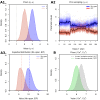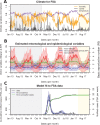Epidemiological and ecological determinants of Zika virus transmission in an urban setting
- PMID: 28887877
- PMCID: PMC5638629
- DOI: 10.7554/eLife.29820
Epidemiological and ecological determinants of Zika virus transmission in an urban setting
Abstract
The Zika virus has emerged as a global public health concern. Its rapid geographic expansion is attributed to the success of Aedes mosquito vectors, but local epidemiological drivers are still poorly understood. Feira de Santana played a pivotal role in the Chikungunya epidemic in Brazil and was one of the first urban centres to report Zika infections. Using a climate-driven transmission model and notified Zika case data, we show that a low observation rate and high vectorial capacity translated into a significant attack rate during the 2015 outbreak, with a subsequent decline in 2016 and fade-out in 2017 due to herd-immunity. We find a potential Zika-related, low risk for microcephaly per pregnancy, but with significant public health impact given high attack rates. The balance between the loss of herd-immunity and viral re-importation will dictate future transmission potential of Zika in this urban setting.
Keywords: Zika; epidemiology; global health; herd-immunity; infectious disease; mathematical model; microbiology; virus.
Conflict of interest statement
No competing interests declared.
Figures










References
-
- Bewick S, Fagan WF, Calabrese JM, Agusto F. Zika Virus: Endemic Versus Epidemic Dynamics and Implications for Disease Spread in the Americas. bioRxiv. 2016:041897
Publication types
MeSH terms
Grants and funding
LinkOut - more resources
Full Text Sources
Other Literature Sources
Medical

